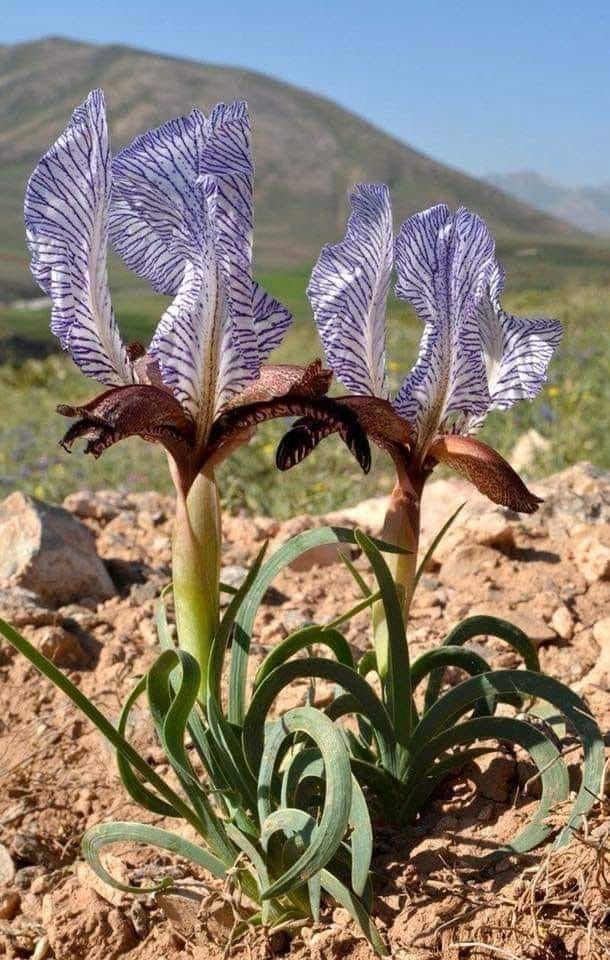If you’re a fan of rare and resilient plants, the Iris iberica is a must-know species. This stunning flower, native to the Caucasus, Iran, and Turkey, is a true marvel of nature. With its striking appearance and remarkable adaptability to harsh climates, the Iris iberica has captivated botanists and garden enthusiasts alike. In this blog, we will explore the fascinating characteristics of this unique iris, its growing conditions, and why it’s such a prized plant for collectors.
The Origins of Iris Iberica
The Iris iberica hails from some of the most rugged regions on Earth—namely, the mountainous areas of the Caucasus (a mountain range straddling Europe and Asia), Iran, and Turkey. These regions are known for their dry, rocky landscapes and extreme weather conditions, which makes the Iris iberica particularly special. This iris species has evolved to thrive in these harsh environments, making it not only a beautiful addition to any garden but also a testament to the resilience of nature.
Adaptability to Harsh Climates
One of the most remarkable features of Iris iberica is its ability to adapt to cool winters and hot summers, with temperatures typically ranging from 10°C to 30°C. This wide temperature range means that the iris can endure the stark contrasts of harsh winters and scorching summers, which are common in its native regions. In fact, Iris iberica has evolved to survive in some of the driest soils, making it a plant that requires very little water to thrive.
Unlike many other flowering plants that demand constant care and attention, Iris iberica is a low-maintenance beauty that flourishes in poor soil conditions. It prefers well-drained soils, often found in rocky, arid areas where few other plants can survive. This hardy iris species has adapted to life in such harsh conditions, making it a perfect choice for gardeners in similar climates or those who wish to create a low-water garden.
Physical Characteristics of Iris Iberica
The Iris iberica is a striking flower that instantly catches the eye. Its petals, which are a deep purple with delicate veining, give the flower a regal and exotic appearance. The dark brown falls (the downward-curving petals of the iris) further enhance its dramatic beauty. The flower’s vivid colors and intricate patterns make it stand out against the backdrop of its dry, rocky habitat.
Iris iberica blooms in late spring to early summer, a time when many plants are reaching their peak. The iris’ flowers appear in clusters, with each bloom perched gracefully atop tall, slender stems. These flowers create a breathtaking contrast against the rocky landscape, making them a perfect feature for arid gardens, dry landscapes, and rockeries.
In addition to its visual appeal, the iris’ compact size and hardiness make it an excellent choice for those looking to add an exotic touch to their garden. Whether planted in containers, rock gardens, or wildflower meadows, the Iris iberica adds a splash of color and elegance wherever it is placed.
Caring for Iris Iberica
While the Iris iberica is a hardy plant, it still requires some care to thrive. Here are a few tips for cultivating this rare species in your garden:
Soil Requirements: Iris iberica thrives in well-drained soils. It’s essential to plant it in an area where water does not accumulate. If you have heavy clay soil, it’s a good idea to amend it with sand or gravel to improve drainage.
Sunlight: This species enjoys full sun, so plant it in a location where it will receive at least six hours of sunlight each day. The bright sunlight helps the plant produce the vibrant colors it’s known for.
Watering: As mentioned earlier, Iris iberica is adapted to dry conditions and does not require frequent watering. Water it sparingly, especially during the growing season, and avoid overhead watering, as this can lead to fungal diseases.
Temperature: This iris species can tolerate a wide range of temperatures, but it’s best suited for areas with cool winters and hot summers, similar to its native environment.
Pruning: After the flowers have bloomed and started to fade, it’s a good idea to remove spent blooms and dead leaves. This will encourage healthier growth and prevent the plant from expending energy on non-productive parts.
Fertilization: Fertilize your Iris iberica with a balanced, slow-release fertilizer in the spring to promote healthy growth and vibrant blooms. Avoid over-fertilizing, as this can lead to excessive foliage growth at the expense of flowers.
Why Botanists Love Iris Iberica
Botanists are particularly fond of Iris iberica for several reasons. First, it is a relatively rare species, making it a prized find for collectors and researchers. Its adaptability to extreme climates is a testament to its evolutionary success, and it serves as an example of nature’s ability to thrive in harsh environments.
Second, the Iris iberica‘s unique appearance, with its purple-veined petals and dark brown falls, sets it apart from other irises. This exotic beauty is often considered a jewel of the plant world, admired for both its aesthetics and its resilience.
Finally, the Iris iberica’s role in the ecosystem is noteworthy. In its native regions, it helps stabilize soil and provides nectar for pollinators like bees and butterflies. As such, it contributes to the biodiversity of the areas in which it grows.
Conclusion: A Must-Have for Garden Enthusiasts
If you’re looking for a hardy, beautiful, and low-maintenance plant to add to your garden, the Iris iberica is an excellent choice. Its stunning flowers, ability to thrive in dry, rocky conditions, and adaptability to extreme climates make it a rare gem in the world of gardening. Whether you live in a region with similar weather patterns to the Caucasus, Iran, and Turkey, or you’re simply looking to experiment with an exotic species, this iris is sure to make an impression.
Embrace the beauty and resilience of Iris iberica, and let it enchant your garden with its captivating colors and unique charm.
More Articles You Might Like
-
Texas Toast Sloppy Joes: The Crunchy, Cheesy Upgrade You Didn’t Know You Needed
There’s something timeless about sloppy joes. For generations, this saucy, savory, and slightly sweet ground beef sandwich has been a go-to comfort food in American kitchens. It’s quick, filling, and family-friendly—perfect for busy weeknights. But what if we told you there’s a way to take this classic dish up a notch? Enter the Texas Toast…
-
Classic Pig Pickin’ Cake
When it comes to Southern desserts, few sweets shine as brightly as the Classic Pig Pickin’ Cake. This nostalgic cake, sometimes called a “Mandarin Orange Cake,” has roots deep in Southern tradition. It gets its playful name from its frequent appearance at pig pickin’s—Southern-style barbecue gatherings where communities come together to enjoy slow-cooked pork, sides,…
-
Lemon Garlic Butter Chicken with Creamy Parmesan Pasta
There’s something irresistible about the combination of tender, golden-browned chicken paired with a creamy pasta coated in Parmesan cheese. Add the brightness of lemon, the depth of garlic, and the richness of butter, and you have a recipe that feels indulgent yet approachable enough for a weeknight dinner. Lemon Garlic Butter Chicken with Creamy Parmesan…



